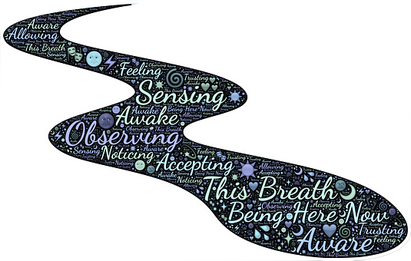This past summer I began practicing pranayama every day as part of my studies toward Iyengar yoga certification. After several weeks I noticed subtle, yet significant changes. Anyone hanging around Ayurveda aficionados soon discovers their obsession with pooping. Sorry to be so graphic, but regular bowel movements are an important indicator for health. Despite a lot of travel, a good amount of Vata (air and ether) in my constitution, and being in the Vata stage of life I was as regular as clockwork. I also felt calmer, unflappable, happier in my own company.
Why had I been so dismissive of this practice? However, classes in pranayama are hard to find and pranayama is often never mentioned in yoga classes. Pranayama is usually translated as control of the breath. Yet "breath" doesn't do justice to such a profound concept: it is the energy permeating the universe. This includes heat, light, gravity, magnetism, electricity, physical, mental, intellectual, sexual, spiritual, and cosmic. Without prana there is no life and it is the prime mover. Power, vitality, life and spirit are all prana.
Why had I been so dismissive of this practice? However, classes in pranayama are hard to find and pranayama is often never mentioned in yoga classes. Pranayama is usually translated as control of the breath. Yet "breath" doesn't do justice to such a profound concept: it is the energy permeating the universe. This includes heat, light, gravity, magnetism, electricity, physical, mental, intellectual, sexual, spiritual, and cosmic. Without prana there is no life and it is the prime mover. Power, vitality, life and spirit are all prana.
Mystery Of Breathing

Modern science tells us much about breathing. Breathing is a movement that involves the skeleton, muscles and organs whose goal is to oxygenate the blood. Respiration is the exchange of gases which takes place in the pulmonary alveoli. The alveoli contain very elastic fibers and there are about 300 million of them.
Although science has discovered much about breathing, precise factors controlling breathing are not understood by physiology. The brainstem appears to be the control center for breathing and receives inputs from bodily receptors and other parts of the brain. This control center directs ventilation appropriate for metabolic demand - running or sleeping require vastly different amounts of ventilation; yet minimizing disturbances to internal homeostasis such as chemical composition of the blood, blood pressure and temperature. It must also adapt to effects of injury and disease.
Although science has discovered much about breathing, precise factors controlling breathing are not understood by physiology. The brainstem appears to be the control center for breathing and receives inputs from bodily receptors and other parts of the brain. This control center directs ventilation appropriate for metabolic demand - running or sleeping require vastly different amounts of ventilation; yet minimizing disturbances to internal homeostasis such as chemical composition of the blood, blood pressure and temperature. It must also adapt to effects of injury and disease.
Five Vayus
The ancient vedic tests describe five types, or directions of prana. Apana vayu is downward movement and is responsible for elimination - movement down and out of the body, like urine, feces, semen and menstrual fluid. Samana vayu maintains the action around the stomach, responsible for digestion, the health of the abdominal organs and integration of the gross body. Udana vayu is upward motion from the abdomen through the throat and Vyana vayu circulates throughout the body via arteries, veins and nerves. Prana vayu moves in the thoracic cavity and controls breathing.
Through the vayus, pranayama increases digestion, cleanses the lungs, neutralizes lactic acid, tones the nerves, brain, spinal cord and cardiac muscles, improves blood and lymph circulation, stimulates peristalsis and cleanses the lungs, liver and other organs.
Through the vayus, pranayama increases digestion, cleanses the lungs, neutralizes lactic acid, tones the nerves, brain, spinal cord and cardiac muscles, improves blood and lymph circulation, stimulates peristalsis and cleanses the lungs, liver and other organs.
What Pantajali has to say

In the Yoga Sutras of Patanjali, II.49-53, he describes pranayama and its effects. "Pranayama is the regulation of the incoming and outgoing flow of breath with retention. It is to be practised only after perfection in asana is attained;" "then the covering of the illumination is weakened;" and the mind also becomes fit for concentration."
The practice of pranayama, or I should say, the art of pranayama, makes it easier to distinguish between the true self and the false self, the observer from the observed. It is an important step in the penetration of the layers of the body/mind toward the soul. This is the core problem of human existence that yoga addresses - instead of observing our bodies, minds and senses, we identify with them and respond to life from that vantage point.
We run from suffering, suppress our awareness, emotions, sensations, distract ourselves with pleasures. The practice of pranayama gives us the opportunity to reach toward the soul.
The practice of pranayama, or I should say, the art of pranayama, makes it easier to distinguish between the true self and the false self, the observer from the observed. It is an important step in the penetration of the layers of the body/mind toward the soul. This is the core problem of human existence that yoga addresses - instead of observing our bodies, minds and senses, we identify with them and respond to life from that vantage point.
We run from suffering, suppress our awareness, emotions, sensations, distract ourselves with pleasures. The practice of pranayama gives us the opportunity to reach toward the soul.


